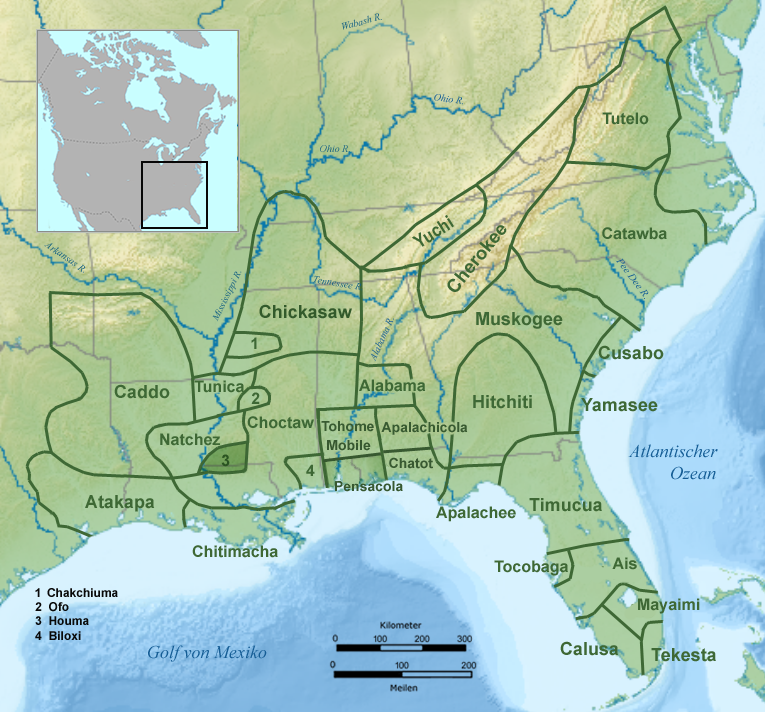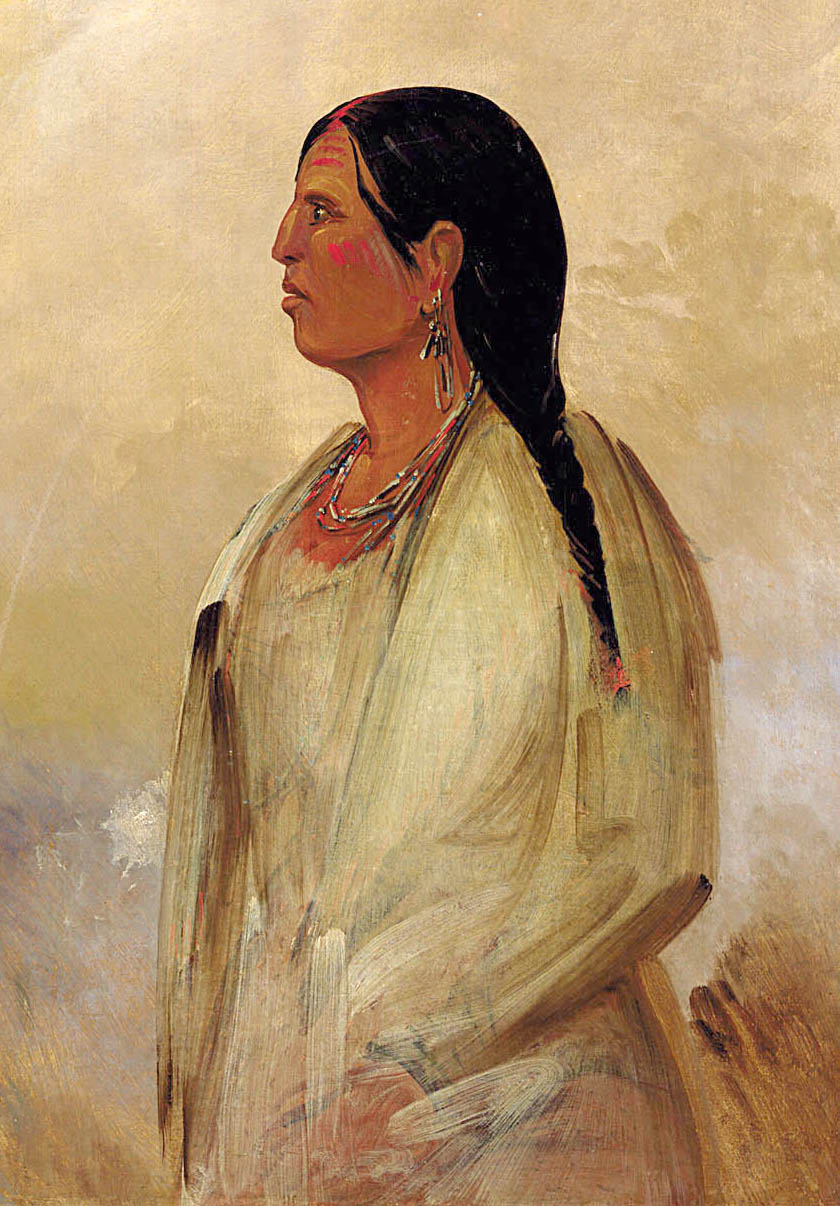|
Acolapissa
The Acolapissa were a small tribe of Native Americans of North America, who lived in the Southeast of what is the present-day United States. They lived along the banks of the Pearl River, between present-day Louisiana and Mississippi. They are believed to have spoken a Muskogean language, closely related to the Choctaw and Chickasaw spoken by other Southeast tribes of the Muskogean family. Early history The Acolapissa had at least six villages. Pierre Le Moyne d'Iberville claimed that the Tangipahoa settlement was an additional Acolapissan settlement. In 1699, a band of 200 Chickasaw, led by two English slave traders, attacked several Acolapissa villages, intending to take captives as slaves to be sold in Charleston, South Carolina. Around 1702 the Acolapissa moved from Pearl River and settled on a bayou on the north side of Lake Pontchartrain. Shortly afterward, Louis Juchereau de St. Denis sent the Natchitoches tribe to live with the Acolapissa, who welcomed them and allowed them ... [...More Info...] [...Related Items...] OR: [Wikipedia] [Google] [Baidu] |
Tangipahoa
The Tangipahoa were a Native American tribe that lived just north of Lake Pontchartrain and between the Pearl River and the Mississippi River. Etymology The name Tangipahoa is derived from the Muskogean words ''(tonche pahoha)'' which translates to "corncob people" or "people of the corn" or "corncob". It is from this Native American tribe that the modern Tangipahoa Parish gets its name, as well as the Tangipahoa River and the village of Tangipahoa. Population Pierre Le Moyne d'Iberville wrote that in the year 1650 the population of both the Acolapissa and Tangipahoa combined consisted of 250 families and around 150 men. However the research by James Mooney determined that a more accurate count was proposed by Jean-Baptiste Bénard de la Harpe when he found that the tribe population was around 1500 people. Language The Tangipahoa language was closely related to Choctaw and Chickasaw, which are both Muskogean languages. History On March 31, 1682 Henri de Tonti on a journey with ... [...More Info...] [...Related Items...] OR: [Wikipedia] [Google] [Baidu] |
Houma People
The Houma () are a historic Native American people of Louisiana on the east side of the Red River of the South. Their descendants, the Houma people or organization "The United Houma Nation", have been recognized by the state as a tribe since 1972, but are not recognized by the federal government. According to the tribe, they have about 17,000 enrolled tribal citizens residing within a six-parish area that encompasses 4,750 square miles. The parishes are St. Mary, Terrebonne, Lafourche, Jefferson, Plaquemines, and St. Bernard. The city of Houma (meaning "red"), and the Red River were both named after this people. Oklahoma shares a similar etymology, as the root ''humma'' means "red" in Choctaw and related Western Muskogean languages, including Houma. Ethnobotany The Houma people take a decoction of dried '' Gamochaeta purpurea'' for colds and influenza.Speck, Frank G., 1941, "A List of Plant Curatives Obtained From the Houma Indians of Louisiana", ''Primitive Man'' 14:4 ... [...More Info...] [...Related Items...] OR: [Wikipedia] [Google] [Baidu] |
Bayogoula
The Bayagoula were a Native American tribe from what is now called Mississippi and Louisiana in the southern United States. Due to transcription errors amongst cartographers who mistakenly rewrote the tribe's name as their name is erroneously assumed to translate as " bayou people"; further corruptions of the tribe's name into the two-word led most later 19th and 20th century cartographers to mistakenly assume the annotation referred not to a tribe but to a bayou near present day Donaldsonville, Louisiana named after some tribe known simply as the "Goula", or to the name of a settlement named after that nonexistent bayou. The Bayagoula were a part of the peoples who spoke Muskogean languages. The Houma people were recorded as attacking them around 1699–1700. They lived with another tribe, the Mougoulacha, in 1700. In the early 18th-century the Bayagoula killed many Mougoulacha, almost exterminating the entire tribe. This was triggered by a fight between the two tribes' chiefs. ... [...More Info...] [...Related Items...] OR: [Wikipedia] [Google] [Baidu] |
Indigenous Peoples Of The Southeastern Woodlands
Indigenous peoples of the Southeastern Woodlands, Southeastern cultures, or Southeast Indians are an ethnographic classification for Native Americans who have traditionally inhabited the area now part of the Southeastern United States and the northeastern border of Mexico, that share common cultural traits. This classification is a part of the Eastern Woodlands. The concept of a southeastern cultural region was developed by anthropologists, beginning with Otis Mason and Frank Boas in 1887. The boundaries of the region are defined more by shared cultural traits than by geographic distinctions.Jackson and Fogelson 3 Because the cultures gradually instead of abruptly shift into Plains, Prairie, or Northeastern Woodlands cultures, scholars do not always agree on the exact limits of the Southeastern Woodland culture region. Shawnee, Powhatan, Waco, Tawakoni, Tonkawa, Karankawa, Quapaw, and Mosopelea are usually seen as marginally southeastern and their traditional lands represent the b ... [...More Info...] [...Related Items...] OR: [Wikipedia] [Google] [Baidu] |
Mougoulacha
The Mougoulacha were a Native Americans in the United States, Native American tribe that lived near Lake Pontchartrain. Population In 1699 Iberville said that the Bayagoula and Mougoulacha together had about 180-250 warriors and an estimated 1,250 people. Language The Mougoulacha language was closely related to Choctaw language, Choctaw and Chickasaw, which are both Muskogean languages. Early History In the year 1699 Pierre Le Moyne d'Iberville journeyed to the east of the Mississippi River Delta and encountered the Mougoulacha tribe. d'Iberville was amazed that the Mougoulacha chief was wearing a Bluecoat, blue serge coat. The chief said that the coat was given to him many years ago when Henri de Tonti explored the area. The Mougoulacha chief then showed d'Iberville a letter that was written in french. d'Ibberville determined that the letter was left by Tonti with the Quinipissa tribe fourteen years earlier. This led d'Iberville to believe that the Mougoulacha were actually the re ... [...More Info...] [...Related Items...] OR: [Wikipedia] [Google] [Baidu] |
Native American Tribes In Louisiana
Native may refer to: People * Jus soli, citizenship by right of birth * Indigenous peoples, peoples with a set of specific rights based on their historical ties to a particular territory ** Native Americans (other) In arts and entertainment * Native (band), a French R&B band * Native (comics), a character in the X-Men comics universe * ''Native'' (album), a 2013 album by OneRepublic * ''Native'' (2016 film), a British science fiction film * ''The Native'', a Nigerian music magazine In science * Native (computing), software or data formats supported by a certain system * Native language, the language(s) a person has learned from birth * Native metal, any metal that is found in its metallic form, either pure or as an alloy, in nature * Native species In biogeography, a native species is indigenous to a given region or ecosystem if its presence in that region is the result of only local natural evolution (though often popularised as "with no human intervention") d ... [...More Info...] [...Related Items...] OR: [Wikipedia] [Google] [Baidu] |
Extinct Native American Peoples
Extinction is the termination of a kind of organism or of a group of kinds (taxon), usually a species. The moment of extinction is generally considered to be the death of the last individual of the species, although the capacity to breed and recover may have been lost before this point. Because a species' potential range may be very large, determining this moment is difficult, and is usually done retrospectively. This difficulty leads to phenomena such as Lazarus taxa, where a species presumed extinct abruptly "reappears" (typically in the fossil record) after a period of apparent absence. More than 99% of all species that ever lived on Earth, amounting to over five billion species, are estimated to have died out. It is estimated that there are currently around 8.7 million species of eukaryote globally, and possibly many times more if microorganisms, like bacteria, are included. Notable extinct animal species include non-avian dinosaurs, saber-toothed cats, dodos, mam ... [...More Info...] [...Related Items...] OR: [Wikipedia] [Google] [Baidu] |
Houma, Louisiana
Houma ( ) is the largest city in, and the parish seat of, Terrebonne Parish in the U.S. state of Louisiana. It is also the largest principal city of the Houma– Bayou Cane–Thibodaux metropolitan statistical area. The city's government was absorbed by the parish in 1984, which currently operates as the Terrebonne Parish Consolidated Government. The population was 33,727 at the 2010 census, an increase of 1,334 over the 2000 census tabulation of 32,393. In 2020, the population estimates program determined 32,467 people lived in the city. At the 2020 census, its population rebounded to 33,406. Many unincorporated areas are adjacent to the city of Houma. The largest, Bayou Cane, is an urbanized area commonly referred to by locals as being part of Houma, but it is not included in the city's census counts, and is a separate census-designated place. If the populations of the urbanized census-designated places were included with that of the city of Houma, the total would ... [...More Info...] [...Related Items...] OR: [Wikipedia] [Google] [Baidu] |
Tattoo
A tattoo is a form of body modification made by inserting tattoo ink, dyes, and/or pigments, either indelible or temporary, into the dermis layer of the skin to form a design. Tattoo artists create these designs using several Process of tattooing, tattooing processes and techniques, including hand-tapped traditional tattoos and modern tattoo machines. The history of tattooing goes back to Neolithic times, practiced across the globe by many cultures, and the symbolism and impact of tattoos varies in different places and cultures. Tattoos may be decorative (with no specific meaning), symbolic (with a specific meaning to the wearer), or pictorial (a depiction of a specific person or item). Many tattoos serve as Rite of passage, rites of passage, marks of status and rank, symbols of religious and spiritual devotion, decorations for bravery, marks of fertility, pledges of love, amulets and talismans, protection, and as punishment, like the marks of outcasts, slaves and convicts. E ... [...More Info...] [...Related Items...] OR: [Wikipedia] [Google] [Baidu] |
Quinipissa
The Quinipissa (sometimes spelled Kinipissa in French sources) were an indigenous peoples of the Americas, indigenous group living on the lower Mississippi River, in present-day Louisiana, as reported by René-Robert Cavelier, Sieur de La Salle in 1682. They were joined together with the Mougoulacha. The combined group shared a village with the Bayagoula. In 1700 the Bayagoula massacred both the Quinipissa and Mougoulacha. In 1682, René-Robert Cavelier, Sieur de La Salle, La Salle encountered a group of Quinipissa living with the Koroa in a village on the western bank of the Mississippi River. Language The Quinipissa may have spoken the same language as the Mougoulacha and Bayagoula. The Bayogoula language, Bayagoula language is only attested with a single word. Albert Gatschet considered Quinipissa a Muskogean language ''Coast Choctaw'' ("Coast Chaʼhta") based on evidence that many peoples of this area spoke the lingua franca Mobilian Jargon and have names that appear to be ex ... [...More Info...] [...Related Items...] OR: [Wikipedia] [Google] [Baidu] |
Allen Wright
Allen Wright ( cho, Kiliahote, italic=no) (born November 1826 – December 2, 1885) was Principal Chief of the Choctaw Republic from late 1866 to 1870. He had been ordained as a Presbyterian minister in 1852 after graduating from Union Theological Seminary in New York City. He was very active in the Choctaw government, holding several elected positions. He has been credited with the name ''Oklahoma'' (Choctaw word meaning "Home of the Red Man" in English) for the land that would become the state.Meserve, John Bartlett. ''Chronicles of Oklahoma'' vol. 19, no. 4, December,1941. Retrieved December 17, 2012Chronicles of Oklahoma After serving in the Confederate Army during the Civil War, Wright was elected as Principal Chief, serving from 1866 to 1870. He was among the signatories of the Reconstruction Treaty of 1866 to re-establish peace with the United States. Wright served as superintendent of schools for the Choctaw Nation from 1880 to 1884. Early life Allen Wright was born ' ... [...More Info...] [...Related Items...] OR: [Wikipedia] [Google] [Baidu] |
Pierre François Xavier De Charlevoix
Pierre François Xavier de Charlevoix, S.J. ( la, Petrus Franciscus-Xaverius de Charlevoix; 24 or 29 October 1682 – 1 February 1761) was a French Jesuit priest, traveller, and historian, often considered the first historian of New France. He had little interest for "a life of suffering and deprivation for the conversion of Indian souls", but "an eager curiosity concerning life". Name Charlevoix's name also appears as Pierre-François-Xavier de Charlevoix, Pierre De Charlevoix, and François-Xavier de Charlevoix. Life Charlevoix was born at Saint-Quentin in the province of Picardy on 24 or 29 October 1682. A descendant from a line of lesser nobility, his father held the post of deputy attorney general. His ancestors had served in positions in "great trust and high responsibility"Charlevoix, Pierre-François-Xavier De. ''History and General Description of New France''. Translated by John Gilmary Shea. Vol. 1. New York: John Gilmary Shea, 1866. 1. such as legal officers, ... [...More Info...] [...Related Items...] OR: [Wikipedia] [Google] [Baidu] |


.jpg)


.jpg)
